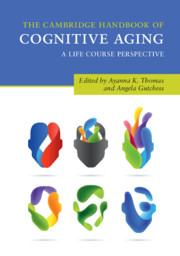Book contents
- The Cambridge Handbook of Cognitive Aging
- The Cambridge Handbook of Cognitive Aging
- Copyright page
- Contents
- Figures
- Tables
- Contributors
- Introduction
- Part I Models of Cognitive Aging
- Part II Mechanisms of Cognitive Aging
- 7 Aging Effects on Brain and Cognition: What Do We Learn from a Strategy Perspective?
- 8 Inhibitory Theory: Assumptions, Findings, and Relevance to Interventions
- 9 From Perception to Action: Bottom-Up and Top-Down Influences on Age Differences in Attention
- 10 Age-Related Sensory Deficits and Their Consequences
- 11 Episodic Memory Decline in Aging
- 12 Age Differences in Decision Making
- 13 Emotion and Memory
- 14 Time Perception from Seconds to Lifetimes: How Perceived Time Affects Adult Development
- Part II Summary: Mechanisms of Cognitive Aging
- Part III Aging in a Socioemotional Context
- Part IV Cognitive, Social, and Biological Factors across the Lifespan
- Part V Later Life and Interventions
- Index
- Plate Section (PDF Only)
- References
9 - From Perception to Action: Bottom-Up and Top-Down Influences on Age Differences in Attention
from Part II - Mechanisms of Cognitive Aging
Published online by Cambridge University Press: 28 May 2020
- The Cambridge Handbook of Cognitive Aging
- The Cambridge Handbook of Cognitive Aging
- Copyright page
- Contents
- Figures
- Tables
- Contributors
- Introduction
- Part I Models of Cognitive Aging
- Part II Mechanisms of Cognitive Aging
- 7 Aging Effects on Brain and Cognition: What Do We Learn from a Strategy Perspective?
- 8 Inhibitory Theory: Assumptions, Findings, and Relevance to Interventions
- 9 From Perception to Action: Bottom-Up and Top-Down Influences on Age Differences in Attention
- 10 Age-Related Sensory Deficits and Their Consequences
- 11 Episodic Memory Decline in Aging
- 12 Age Differences in Decision Making
- 13 Emotion and Memory
- 14 Time Perception from Seconds to Lifetimes: How Perceived Time Affects Adult Development
- Part II Summary: Mechanisms of Cognitive Aging
- Part III Aging in a Socioemotional Context
- Part IV Cognitive, Social, and Biological Factors across the Lifespan
- Part V Later Life and Interventions
- Index
- Plate Section (PDF Only)
- References
Summary
Discussions of age differences in attention often start with the heuristic that older adults show reductions in top-down, goal-driven controlled attention compared to young adults, but relatively preserved bottom-up, stimulus-driven, and more automatic attentional functions. However, age differences in sensorimotor function can reduce the bottom-up salience of environmental stimuli. This can in turn lead to seemingly paradoxical findings of larger age-related deficits in very simple tasks that rely almost entirely on bottom-up attention than those that make moderate, but still-achievable, demands on top-down attention, and thus present opportunities for compensation. We suggest that just as attention represents the interplay of sensory and cognitive function, some of the most interesting and important age differences in attention occur at the interplay of top-down and bottom-up processes. New directions for the field include an increasing emphasis on the additional interplay between cognitive and motivational processes, and their physiological basis.
Keywords
Information
- Type
- Chapter
- Information
- The Cambridge Handbook of Cognitive AgingA Life Course Perspective, pp. 161 - 178Publisher: Cambridge University PressPrint publication year: 2020
